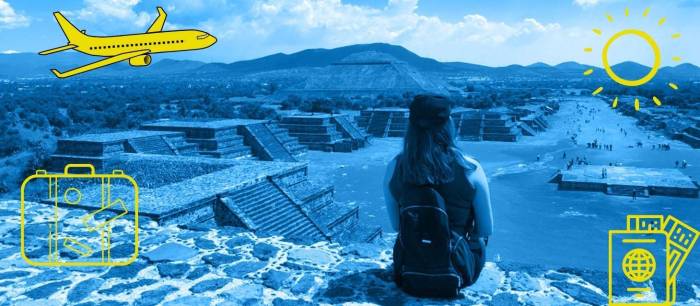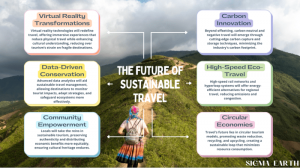
Travel hacks for digital nomads: Embark on a journey of seamless global exploration and remote work. This guide unveils insider tips and strategies to navigate the unique challenges and opportunities faced by digital nomads, from securing affordable flights and mastering train travel to finding budget-friendly accommodation and maximizing vacation rentals. We’ll explore unconventional options like houseboats and RVs, ensuring you make the most of your location-independent lifestyle.
Discover how to optimize your travel budget, find reliable internet access wherever you go, and create a comfortable and productive workspace on the road. Whether you prefer exploring bustling cities or secluded countryside escapes, this guide provides the essential knowledge to transform your nomadic dreams into reality, streamlining your travel planning and maximizing your time and resources.
Finding Affordable Flights for Digital Nomads: Travel Hacks For Digital Nomads
Securing affordable flights is crucial for digital nomads, who often travel extensively on a budget. This section explores effective strategies and tools to minimize flight costs, maximizing your travel opportunities and financial flexibility. Understanding the nuances of flight search engines and employing smart booking techniques can significantly impact your overall travel budget.
Comparison of Flight Search Engines
Several flight search engines offer varying features and capabilities. Google Flights, Skyscanner, Kayak, and Momondo are popular choices, each with strengths and weaknesses. Google Flights excels in its calendar view, visually displaying price fluctuations over time, enabling you to identify the cheapest days to fly. Skyscanner is known for its comprehensive search across numerous airlines and travel agencies, often uncovering hidden deals.
Kayak aggregates results from various sources, providing a broad overview, while Momondo focuses on price comparison and flexible date searches. Each platform offers a slightly different user experience and search algorithm, so exploring several is recommended to ensure you find the best deals.
Strategies for Securing the Lowest Airfares
Employing these strategies significantly increases your chances of finding budget-friendly flights.
- Be Flexible with Your Dates: Mid-week flights (Tuesdays and Wednesdays) and flights during the off-season are generally cheaper than weekend or peak season travel. Experimenting with dates within a flexible range of a week or more can reveal substantial savings.
- Consider Alternative Airports: Flying into smaller, less popular airports near your destination can often lead to lower fares. Research nearby airports and factor in ground transportation costs to determine the overall value.
- Book in Advance or at the Last Minute (Strategically): While booking in advance is often recommended, sometimes last-minute deals emerge. Monitoring prices closely using price tracking tools offered by some search engines can alert you to sudden drops. However, last-minute bookings carry the risk of limited availability and higher prices.
- Clear Your Browser Cookies and Use Incognito Mode: Airlines and travel agencies sometimes track your searches, potentially inflating prices based on perceived demand. Clearing your cookies and using incognito mode can help avoid this.
- Utilize Flight Comparison Websites Effectively: Don’t rely on just one website. Cross-reference prices across multiple platforms like Google Flights, Skyscanner, Kayak, and Momondo to compare and find the best offers. Remember to check the final price including baggage fees and other charges.
Flight Booking Platform Comparison
The following table compares three popular flight booking platforms based on key criteria. Note that prices are dynamic and can change rapidly.
| Platform | Price Competitiveness | Flexibility (changes/cancellations) | Customer Service |
|---|---|---|---|
| Google Flights | Highly competitive, often reveals hidden deals through its calendar view | Policies vary depending on the airline; check terms carefully. | Limited direct customer support; relies primarily on airline and agency support. |
| Skyscanner | Generally competitive; known for finding deals from lesser-known airlines. | Flexibility depends on the airline and fare type; review terms before booking. | Customer support varies; some users report difficulties with resolving issues. |
| Kayak | Competitive, aggregates results from multiple sources for comprehensive comparison. | Flexibility depends on the airline and fare type; review terms before booking. | Offers various contact methods including email and phone; response times can vary. |
Mastering Train Travel as a Digital Nomad
Train travel offers a unique alternative to air travel for digital nomads, providing a slower pace, often more scenic routes, and the opportunity to work productively while in transit. While air travel prioritizes speed, train journeys prioritize comfort and a different kind of experience, potentially leading to a more enriching and less stressful travel style. This section explores the advantages and disadvantages of train travel for digital nomads, guiding you through the process of international train booking and providing essential resources.The primary advantage of train travel lies in its convenience.
Unlike air travel, where you must arrive hours before departure, train travel allows for a more relaxed approach. Boarding is often simpler, and you can freely move about the carriage, accessing Wi-Fi and outlets more readily. This freedom makes it ideal for working remotely. Furthermore, train travel often provides breathtaking views and a more immersive experience of the countries you’re traversing.
However, train journeys are typically longer than flights, which can be a significant drawback for time-sensitive nomads. The cost may also be higher than budget flights, especially for long distances. Lastly, the availability of train routes may be limited compared to air travel, particularly in certain regions of the world.
Booking International Train Tickets
Successfully booking international train tickets involves strategic planning and the utilization of various resources. First, determine your origin and destination cities and the desired travel dates. Many international train routes require advance booking, sometimes months in advance, especially during peak season. Next, compare prices across different booking platforms. Websites often offer varying prices, so it’s crucial to explore multiple options.
Consider utilizing a price comparison website to streamline this process. Once you’ve found the best price, carefully review the terms and conditions before completing your purchase. Remember to check for any baggage restrictions and ensure your passport is valid for the duration of your journey. Finally, print or save a digital copy of your ticket and any relevant travel documents.
Saving Money on International Train Tickets
Several strategies can significantly reduce the cost of international train travel. Firstly, book well in advance to take advantage of early-bird discounts. Many train companies offer substantial savings for tickets purchased several weeks or even months prior to the departure date. Secondly, travel during the off-season or on weekdays to avoid peak travel times. Prices are generally higher during holidays and weekends.
Thirdly, consider flexible travel dates. If your schedule permits, exploring alternative travel dates can often reveal lower fares. Fourthly, explore regional or national rail passes if your itinerary involves multiple train journeys within a specific region. These passes can offer substantial cost savings compared to purchasing individual tickets. Lastly, consider traveling overnight to avoid the cost of accommodation.
Many train companies offer sleeper cars, providing a comfortable and cost-effective way to travel overnight.
Essential Apps and Websites for Planning and Booking Train Journeys
A range of apps and websites simplifies the process of planning and booking international train journeys. These tools provide comprehensive information on routes, schedules, and prices, often integrating features for comparing fares and booking tickets directly.
- Trainline: A popular platform offering a wide range of international train routes and convenient booking options.
- Rail Europe: Specializes in European train travel, providing comprehensive information and booking services for various rail networks.
- Rome2rio: A multimodal transportation planner that compares different travel options, including trains, buses, and flights, helping you find the most suitable route.
- Google Maps: While primarily known for mapping, Google Maps provides real-time information on train schedules and allows you to plan your journey.
These apps and websites offer features such as real-time schedule updates, fare comparisons, mobile ticketing, and customer support, making international train travel significantly easier to manage. Selecting the right tool depends on your specific travel needs and preferences. For example, Trainline offers a user-friendly interface and broad international coverage, while Rail Europe excels in its expertise in European rail travel.
Planning Epic Road Trips for the Digital Nomad Lifestyle
Embarking on a road trip as a digital nomad offers unparalleled freedom and flexibility, allowing you to explore new places while maintaining your work routine. Careful planning, however, is key to maximizing both the travel and work aspects of this exciting lifestyle choice. This section will Artikel three diverse road trip itineraries, essential tools for planning and navigation, and a packing checklist tailored to the digital nomad’s needs.
Three Diverse Road Trip Itineraries for Digital Nomads
These itineraries showcase diverse landscapes and offer varying levels of infrastructure, catering to different preferences and work styles. Each is designed to balance exploration with reliable internet access and comfortable workspaces.
- The Pacific Coast Highway, USA (2-3 weeks): This iconic route offers stunning coastal scenery, numerous charming towns with co-working spaces and cafes, and reliable internet access. The itinerary could start in San Francisco, working your way down to Los Angeles, with stops in Big Sur, Monterey, and Santa Barbara. This trip provides a blend of natural beauty and readily available amenities for digital nomads.
- Southeast Asia Overland Adventure (1-2 months): A longer trip focusing on cultural immersion and budget-friendly travel. Starting in Bangkok, Thailand, this route could traverse through Laos, Vietnam, and Cambodia. While internet access may be more sporadic in certain areas, many guesthouses and cafes offer reliable Wi-Fi. This itinerary prioritizes cultural experiences alongside work, with opportunities to explore ancient temples, bustling markets, and stunning natural landscapes.
Expect a more adventurous and less structured approach.
- The Transfăgărășan Highway, Romania (1 week): For those seeking a shorter, more intense road trip, the Transfăgărășan Highway in Romania offers breathtaking mountain scenery and a challenging driving experience. This route is ideal for digital nomads who value stunning natural landscapes and can work effectively from a variety of locations, potentially utilizing mobile hotspots in areas with limited Wi-Fi.
Essential Tools and Apps for Planning and Navigating Road Trips
Effective planning and navigation are paramount for a successful road trip, especially for digital nomads who need to ensure reliable internet access and find suitable workspaces along the way.
- Google Maps/Waze: For navigation and real-time traffic updates. Offline maps are essential for areas with limited connectivity.
- Roadtrippers: This app helps discover points of interest, restaurants, and accommodation along your route, filtering by amenities relevant to digital nomads (Wi-Fi, co-working spaces).
- WorkFrom.co: A database of co-working spaces and cafes with reliable Wi-Fi, crucial for maintaining productivity while traveling.
- VPN: A Virtual Private Network is crucial for secure and reliable internet access, especially in public Wi-Fi hotspots.
- Weather apps: Essential for planning daily activities and packing accordingly.
Digital Nomad Road Trip Packing Checklist
Packing efficiently is crucial for a smooth road trip. This checklist prioritizes items essential for both travel and remote work.
- Laptop and necessary tech accessories (charger, adapter, etc.): The foundation of your digital nomad lifestyle.
- Portable Wi-Fi hotspot or international data SIM card: Ensuring reliable internet connectivity.
- Power bank: For charging devices on the go.
- Universal travel adapter: For charging devices in different countries.
- Comfortable clothing and appropriate footwear: For both work and exploration.
- First-aid kit and necessary medications: For unexpected health issues.
- Travel documents (passport, driver’s license, visa, etc.): Essential for smooth travel.
- Portable document scanner: For creating digital copies of important documents.
Securing Budget-Friendly Accommodation

Finding affordable yet comfortable accommodation is crucial for digital nomads aiming to maximize their travel budget. The right lodging can significantly impact your productivity and overall travel experience, influencing everything from your work environment to your ability to explore your surroundings. This section explores various budget-friendly options and strategies to help you secure the perfect base for your nomadic adventures.Finding the right balance between cost and comfort requires careful consideration of several factors, including location, amenities, and the overall atmosphere.
While some digital nomads prioritize the cheapest option, others recognize the value of a comfortable workspace and social environment. The optimal choice depends entirely on your individual needs and priorities.
Budget Accommodation Options for Digital Nomads
Hostels, guesthouses, and Airbnb are among the most popular choices for budget-conscious digital nomads. Hostels, often known for their social atmosphere and shared facilities, generally offer the lowest nightly rates. Guesthouses provide a more private experience with individual or private rooms, but at a slightly higher price point. Airbnb offers a wider range of options, from private rooms in shared homes to entire apartments, providing flexibility in terms of space, amenities, and privacy.
The cost varies greatly depending on location and the type of accommodation chosen. For instance, a dorm bed in a hostel in Southeast Asia might cost $10-$20 per night, while a private room in a guesthouse in Western Europe could be $50-$100 or more. An Airbnb apartment in a popular city could range from $30-$200 per night or even more, depending on location and season.
Finding Hidden Discounts and Deals on Accommodation
Several online platforms and strategies can help digital nomads uncover hidden discounts and deals on accommodation. Websites like Booking.com, Hostelworld, and Expedia frequently offer discounts and promotions. These platforms also allow users to filter results based on price, amenities, and guest ratings. Additionally, signing up for newsletters and email alerts from these platforms can provide early access to exclusive deals and flash sales.
Utilizing price comparison websites can also reveal significant savings. These websites simultaneously search across multiple booking platforms, enabling you to quickly identify the best price available. Finally, flexible travel dates can significantly impact the price. Traveling during the shoulder season (the periods between peak and off-season) often results in lower accommodation costs. For example, traveling to a popular European city in the spring or fall, rather than during the summer peak season, can lead to significant savings.
Negotiating Lower Prices and Securing Better Deals on Accommodation
Directly contacting accommodation providers can sometimes yield better deals. Many guesthouses and smaller Airbnb hosts are willing to negotiate, especially for longer stays. Clearly stating your intention to stay for an extended period (a week or more) can often result in a discounted rate. Similarly, booking directly with the property instead of through a third-party platform can sometimes lead to lower prices and better service.
Being flexible with your dates and preferences can also strengthen your negotiating position. Showing willingness to compromise on room type or amenities might lead to a better overall deal. For instance, opting for a smaller room or a room without a view can often lead to a lower price. Finally, politely inquiring about any ongoing promotions or discounts can uncover hidden deals that are not readily advertised.
Maximizing Vacation Rentals and Airbnb Stays
Airbnb and similar platforms offer a compelling alternative to traditional hotels for digital nomads, providing more space, often better equipped for remote work, and a more localized experience. However, long-term stays require careful consideration of both advantages and disadvantages to ensure a successful and productive experience.The appeal of using Airbnb for extended periods lies primarily in the potential for cost savings, particularly when compared to hotel rates over several weeks or months.
Furthermore, many Airbnb properties offer amenities crucial for digital nomads, such as high-speed internet, dedicated workspaces, and fully equipped kitchens. This allows for greater comfort and flexibility compared to the often more limited amenities of a hotel room. However, the lack of consistent service levels, potential for unexpected issues with the property or host, and the absence of certain hotel amenities (such as daily housekeeping) represent significant drawbacks.
Finding Suitable Long-Term Airbnb Accommodations
Locating a comfortable and well-equipped Airbnb for extended stays requires a proactive approach. Begin by defining your essential requirements: high-speed internet, a dedicated workspace, comfortable furniture, and proximity to reliable transportation and local amenities. Utilize Airbnb’s advanced search filters to refine your results based on these criteria, specifying the length of your stay. Read reviews meticulously, paying close attention to comments about internet speed and reliability, noise levels, and the host’s responsiveness.
Consider contacting potential hosts directly to clarify any uncertainties or request additional photos or information about the workspace. Look for properties with positive reviews mentioning their suitability for remote workers, often highlighting aspects such as ergonomic chairs and reliable Wi-Fi. For example, a review mentioning “great workspace with a comfortable desk and fast, stable Wi-Fi” would be particularly helpful.
Communicating Effectively with Airbnb Hosts
Open and proactive communication is key to a successful long-term Airbnb stay. Before booking, clarify your needs regarding internet speed, workspace availability, and any specific amenities crucial for your work. Once booked, establish a friendly and professional rapport with your host. Inform them of your estimated work schedule and any potential disruptions, such as receiving deliveries or having guests over.
This demonstrates respect for their property and helps prevent misunderstandings. If any issues arise during your stay, address them promptly and calmly, ideally using the Airbnb platform’s messaging system to maintain a record of communication. For instance, if the internet experiences a temporary outage, promptly inform your host to facilitate a quicker resolution. Regular check-ins with your host, perhaps a brief message once a week, can help foster a positive relationship and address any concerns proactively.
Hotel Hacks for Digital Nomads
Hotels can be a fantastic option for digital nomads, offering a blend of comfort, convenience, and often, reliable amenities crucial for remote work. However, navigating the hotel landscape to find the best value and suitability for your nomadic lifestyle requires a strategic approach. This section will Artikel key strategies for maximizing your hotel stays as a digital nomad.
Choosing the right hotel significantly impacts your productivity and overall travel experience. Factors such as internet speed, workspace availability, and location relative to your work commitments are paramount. Understanding the nuances of hotel loyalty programs and negotiation tactics can unlock significant savings, transforming a potentially expensive lodging option into a cost-effective and comfortable base of operations.
Identifying Hotels with Excellent Amenities for Remote Workers
Finding hotels catering to remote workers involves more than just checking for Wi-Fi availability. Look for hotels advertising dedicated workspaces, business centers with printers and other office equipment, ergonomic chairs, and ample desk space. Reviews often highlight the quality of internet connection – search for comments mentioning reliable high-speed internet, particularly if you rely heavily on video conferencing or large file transfers.
Consider hotels near co-working spaces as an alternative or supplement to in-room work options. Many upscale hotels now offer dedicated “work from hotel” packages that bundle these amenities together.
Leveraging Loyalty Programs and Negotiating Better Rates at Hotels, Travel hacks for digital nomads
Hotel loyalty programs offer a multitude of benefits for frequent travelers. Points earned through stays can be redeemed for free nights, upgrades, or other perks. Some programs even offer complimentary breakfast or internet access. Beyond loyalty programs, direct negotiation with hotels, particularly during off-season or periods of low occupancy, can sometimes yield significantly discounted rates. Explaining your extended stay and highlighting your potential to become a repeat customer can be persuasive.
Booking directly through the hotel website, rather than third-party platforms, often allows for greater flexibility and potential for negotiation.
Pros and Cons of Different Hotel Chains in Terms of Value and Suitability for Digital Nomads
Different hotel chains cater to different needs and budgets. Budget chains like Motel 6 or Travelodge may offer basic accommodation at low prices, but often lack the amenities crucial for digital nomads, such as reliable Wi-Fi or comfortable workspaces. Mid-range chains like Holiday Inn Express or Hampton Inn frequently provide free breakfast and decent Wi-Fi, making them suitable for shorter stays or those on tighter budgets.
Upscale chains like Marriott or Hilton offer superior amenities, including business centers, high-speed internet, and comfortable workspaces, but come at a significantly higher price point. Boutique hotels often provide unique experiences and personalized service but may lack the consistency of larger chains. The best choice depends on individual priorities and budget. For example, a digital nomad prioritizing reliable internet and a quiet workspace might opt for a mid-range or upscale chain, whereas someone focusing on affordability might choose a budget option and supplement with co-working space memberships.
RV and Campervan Adventures
Embarking on a digital nomad journey in an RV or campervan offers a unique blend of freedom and flexibility. This mode of travel allows you to explore at your own pace, work remotely from stunning locations, and truly immerse yourself in the local culture. However, it also presents distinct challenges that require careful planning and preparation. This section will delve into the advantages, challenges, and practicalities of RV and campervan living for the digital nomad.The allure of RV and campervan travel lies in its unparalleled freedom.
Unlike hotels or rental properties, you are not confined to a specific location. You can wake up to breathtaking mountain views one day and the ocean’s roar the next. This flexibility is especially appealing to digital nomads who can work from virtually anywhere with a reliable internet connection. The ability to explore less-traveled routes and experience off-the-beaten-path destinations adds another layer of adventure to the nomadic lifestyle.
However, the freedom comes with responsibilities such as maintenance, finding suitable campsites, and managing resources carefully.
Essential Equipment and Supplies for RV/Campervan Travel
A well-stocked RV or campervan is crucial for a comfortable and safe journey. Careful planning is vital to ensure you have everything you need for both daily life and unforeseen circumstances. Neglecting to pack essential items can lead to frustration and inconvenience on the road.
- Navigation and Communication: A reliable GPS device, offline maps, and a satellite phone or international roaming plan are essential for navigating unfamiliar territories and staying connected.
- Cooking and Food Storage: A portable camping stove, cookware, utensils, and sufficient food storage containers are necessary for preparing meals on the road. Consider a cooler with ice packs for perishable items.
- Personal Hygiene and First Aid: A comprehensive first-aid kit, toiletries, and sufficient medications are crucial for maintaining hygiene and handling minor injuries or illnesses.
- Power and Electronics: A portable power station, solar panels, and adapters for various power outlets are essential for charging electronic devices. Consider a surge protector for sensitive equipment.
- Safety and Security: Basic tools for minor repairs, a tire pressure gauge, a first-aid kit, and personal safety devices (such as pepper spray) should be included.
- Clothing and Bedding: Pack versatile and weather-appropriate clothing, along with bedding suitable for various temperatures.
- Documents and Finances: Ensure you have copies of your passport, driver’s license, insurance information, and sufficient funds, preferably with multiple payment methods.
Finding Campsites and RV Parks with Reliable Internet Access
Securing reliable internet access is paramount for digital nomads. Finding campsites and RV parks with robust Wi-Fi is therefore a key consideration. Many parks advertise Wi-Fi, but the quality can vary significantly.Finding reliable internet access while traveling in an RV or campervan requires proactive planning. Utilizing online resources and apps that review campsites and provide user feedback on internet speeds and reliability is a smart strategy.
Consider these approaches:
- Utilize Online Resources: Websites and apps like Campendium, The Dyrt, and iOverlander provide user reviews and ratings of campsites, including information about internet access quality.
- Contact Campsites Directly: Before booking, contact campsites directly to inquire about the reliability and speed of their Wi-Fi. Ask about potential dead zones or limitations.
- Consider Alternative Internet Solutions: A mobile hotspot with a generous data plan, a satellite internet connection, or a portable cellular booster can provide backup internet access in areas with weak Wi-Fi.
- Explore Coffee Shops and Libraries: When in towns or cities, utilize free Wi-Fi available in coffee shops, libraries, and other public spaces to supplement your RV’s internet access.
Unconventional Accommodation Options
Digital nomads seeking a unique travel experience often find themselves drawn to unconventional accommodation options. These alternatives to traditional hotels and hostels offer a chance to immerse themselves in local culture and enjoy a more authentic travel experience, often at a comparable or even lower cost. This exploration of unique lodging choices will examine their suitability for remote work, highlighting the advantages and disadvantages each presents.Exploring unique accommodation options such as treehouses, yurts, and cabins offers digital nomads a blend of adventure and practicality.
These options provide a change of pace from standard hotels, often offering a more secluded and inspiring work environment. However, it’s crucial to weigh the pros and cons carefully, considering factors like internet connectivity, workspace availability, and overall comfort levels before making a booking. The cost of these unique stays varies widely depending on location, amenities, and seasonality.
Treehouse Stays
Treehouses offer a whimsical and secluded escape, perfect for those seeking a tranquil work environment surrounded by nature. Many modern treehouses are equipped with comfortable amenities, including reliable Wi-Fi, comfortable workspaces, and even private balconies. However, the secluded nature can sometimes mean limited access to amenities and services found in traditional accommodations. Internet connectivity can also be inconsistent depending on the location and the treehouse’s construction.
A well-equipped treehouse in a remote forest setting might offer breathtaking views and complete peace and quiet, ideal for focused work, but could lack the convenience of nearby shops or restaurants. Conversely, a treehouse in a more developed area might offer easier access to amenities but sacrifice some of its secluded charm.
Yurt Accommodations
Yurts, traditional circular tents originating from Central Asia, provide a unique blend of comfort and cultural immersion. Many yurt accommodations are now designed with digital nomads in mind, offering features such as electricity, Wi-Fi, and comfortable workspaces. The cost of a yurt stay can be highly variable, depending on its location and amenities. A yurt in a remote area might be significantly cheaper than a similarly equipped yurt in a popular tourist destination.
The nomadic nature of yurts often means a lack of consistent amenities, while the circular design can sometimes create challenges for setting up a dedicated workspace. However, the unique atmosphere and immersive experience can be invaluable for creativity and inspiration.
Cabin Retreats
Cabins, ranging from rustic log cabins to modern, luxurious getaways, offer a balance between comfort and nature. Many cabins provide reliable internet access and dedicated workspaces, making them suitable for digital nomads. The cost of a cabin stay can vary dramatically based on size, location, and amenities. A secluded cabin in the mountains might be more affordable than a luxury cabin near a popular ski resort.
While some cabins offer complete privacy and a peaceful work environment, others might be located in more populated areas, sacrificing some of the seclusion. The availability of amenities, such as reliable internet and comfortable workspaces, should be carefully considered before booking. For instance, a rustic cabin might offer a charming experience but lack high-speed internet, whereas a modern cabin might offer all the amenities of a hotel but at a higher cost.
Houseboat and Yacht Stays for Remote Workers

The allure of working remotely from a houseboat or yacht is undeniable – imagine waking up to stunning waterfront views, enjoying a midday swim, and ending your workday with a breathtaking sunset. This lifestyle offers a unique blend of work and leisure, appealing to digital nomads seeking adventure and a change of pace from traditional accommodations. However, the feasibility and practicality of this unconventional living arrangement require careful consideration.Houseboat and yacht living presents a compelling alternative for digital nomads seeking a less conventional work-life integration.
The lifestyle offers unparalleled access to nature and unique work environments, fostering creativity and a sense of freedom. However, the costs and logistical complexities involved must be carefully weighed against the benefits.
Cost Comparison: Houseboats versus Yachts
The cost of living aboard a houseboat or yacht varies dramatically depending on size, location, and amenities. Generally, houseboats tend to be more affordable than yachts, particularly smaller models in less desirable locations. A well-maintained houseboat in a less popular area might cost a few thousand dollars per month, including mooring fees and basic utilities. Conversely, renting or chartering a luxury yacht can easily exceed tens of thousands of dollars monthly, encompassing maintenance, docking, and crew costs.
Ownership introduces additional expenses like insurance, repairs, and potentially staff salaries. For example, a smaller houseboat in Thailand might cost significantly less than a similar-sized vessel in the Mediterranean. A luxury yacht in the Caribbean will undoubtedly command a far higher price than a houseboat in the Pacific Northwest.
Logistical Challenges of Houseboat and Yacht Living
Maintaining reliable internet access is paramount for remote workers. While satellite internet is an option, it can be expensive and prone to disruptions, especially in remote locations. Additionally, power supply can be an issue, requiring careful planning and potentially the use of generators. Access to essential services like healthcare and groceries may also be limited depending on the location.
The mobility of houseboats and yachts, while a benefit, can also present logistical challenges when it comes to securing reliable internet and postal services. For instance, securing a consistent internet connection on a yacht cruising through the Pacific Ocean would require substantial investment in satellite technology and potentially necessitate frequent stops in areas with better connectivity.
Suitable Locations for Houseboat and Yacht Living
Several locations worldwide offer ideal conditions for houseboat and yacht living. Southeast Asia, particularly Thailand and Vietnam, boasts affordable houseboat options in picturesque locations with relatively reliable internet access. The Mediterranean offers a more luxurious option, with numerous marinas and yacht charters available. The Caribbean provides a tropical paradise with stunning scenery, though costs tend to be higher.
In the United States, areas like the Pacific Northwest and Florida offer opportunities for houseboat living, with varying levels of affordability and accessibility. Each location presents a unique set of advantages and disadvantages, including climate, cost of living, and internet infrastructure. For example, the canals of Amsterdam offer a unique and centrally located option for houseboat living, but come with the premium cost associated with a highly sought-after urban location.
Mastering the art of digital nomad travel involves more than just booking flights and finding a place to stay; it’s about strategically optimizing your resources and maximizing your experiences. By implementing the travel hacks Artikeld in this guide, you’ll not only save money and time but also unlock a more fulfilling and productive nomadic lifestyle. Embrace the freedom of location independence with confidence and efficiency, transforming your travel into an enriching adventure.
Questions and Answers
What are the best travel insurance options for digital nomads?
Several companies offer comprehensive travel insurance tailored to digital nomads, covering medical emergencies, lost equipment, and trip cancellations. Research providers and compare plans to find the best coverage for your specific needs and budget.
How can I stay connected while traveling as a digital nomad?
Reliable internet access is crucial. Consider using a portable Wi-Fi hotspot, purchasing local SIM cards, or utilizing free Wi-Fi in cafes and co-working spaces. Research internet availability in your chosen destinations beforehand.
What are some essential safety tips for solo digital nomad travelers?
Prioritize safety by sharing your itinerary with loved ones, being mindful of your surroundings, and avoiding risky situations. Research local customs and laws, and be aware of common scams.
How do I manage my finances effectively while traveling long-term?
Open a multi-currency bank account, use budgeting apps to track expenses, and consider using a travel credit card with rewards and travel insurance. Set a realistic budget and stick to it.





